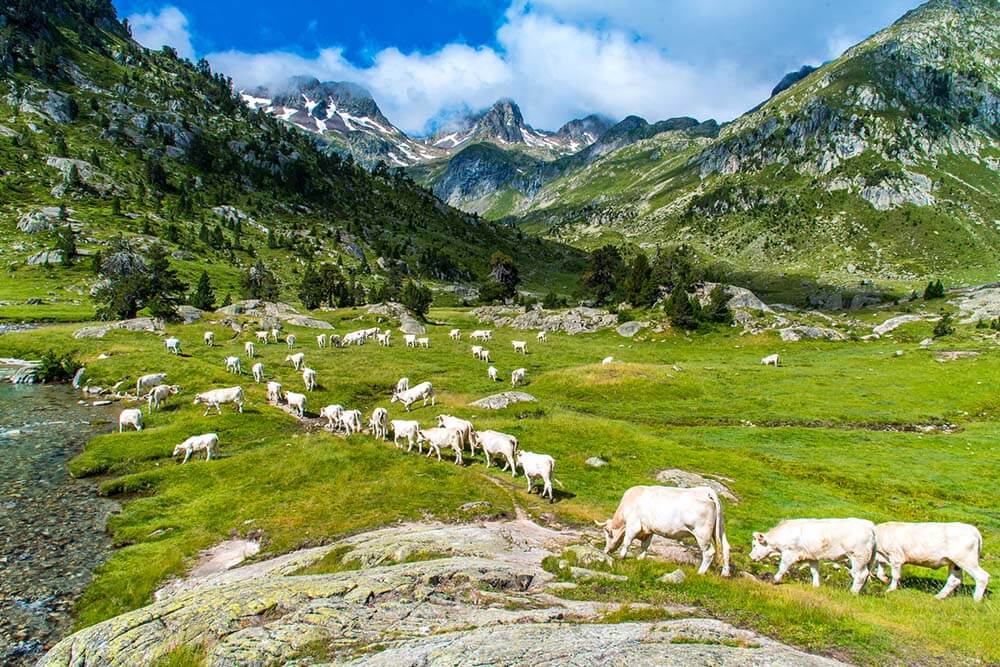
Straddling the border of France and Spain, the Pyrénées mountain range is one of Europe’s best-kept secrets. They may not be as well-known as the Alps, but they are as dramatic. In fact, the Pyrénées beauty and ruggedness combined with their relatively uncrowded trails, make them a spectacular place to visit and trek in.
The Trek

Ryder-Walker’s Haute Pyrénées trek begins in Cauterets, France, a charming ski and spa town in the heart of the Pyrénées. On day one, you get a preview of the week to come as we ascend up into one of the most beautiful valleys in the Pyrénées, Vallee du Marcadau. Here, we eat a delicious lunch at the Refuge Wallon Marcadau before returning to our hotel in Cauterets for the night.
The next day, we hike up the flanks of the Petit Vignemale to Refuge de Bayssellance, the highest refuge in the Pyrénées, and home for the night. After an early hut breakfast, the following morning, we travel to Cirque du Gavarnie, a gorgeous amphitheater ringed by massive rock walls and huge waterfalls—indeed one of the most impressive mountain features in Europe.
We overnight in a castle-like hotel in Gavarnie, a town granted UNESCO World Heritage status sheerly based on its scenery. After a more mellow hike in the Cirque du Gavarnie, we cross the border, switching up languages and cuisine as we climb from the Parc National des Pyrénées Occidentales into the Parque Nacional de Ordesa y Monte Perdido.
Our final two evenings are spent in Torla, wining and dining by night, and exploring the carved sandstone canyons that flank the Spanish side by day.
Geology
Stretching from the Mediterranean Sea on the east to the Atlantic Ocean on the west, the Pyrénées encompass just about every major biome. These include lush grasslands, river-sculpted canyons, limestone spires, and glacier-capped peaks. Aneto, standing at 11,168 feet, is the highest point in the range.
As the Pyrénées are a relatively young set of mountains, there are numerous hot springs bubbling throughout the region, several of which are open to the public.
Glaciers rumbled over much of the range, resulting in sharp arêtes, U-shaped valleys, and waterfalls cascading out of hanging valleys. The most famous and beautiful combination of this is Cirque du Gavarnie, which we visit on this tour.
Anthropology/ Modern Culture
Humans have called this part of the world home for thousands of years. Evidence of this can be seen in the painted caves around the Tarascon-sur-Ariege. This is a prehistoric site on par with the Dordogne caves of southern France. In more recent history, a diverse collection of cultures including the Catalan and the Basque have laid claim to this land. As a result, as we hike up and down these trails. We not only hear Spanish and French, but also Basque. Basque is a language that pre-dates the more common Latin-based linguistics of the region. We also hear Catalan, another Romance language.
Wildlife
 Although humans have impacted this environment in a myriad of ways, the wildlife of the Pyrénées remain vibrant. Throughout these hills, you’ll find marmots, bear, deer, and boar, as well as the often sighted isard, a Pyrenean chamois. Birds of prey crisscross the valleys, riding out the thermals that ripple through the air.
Although humans have impacted this environment in a myriad of ways, the wildlife of the Pyrénées remain vibrant. Throughout these hills, you’ll find marmots, bear, deer, and boar, as well as the often sighted isard, a Pyrenean chamois. Birds of prey crisscross the valleys, riding out the thermals that ripple through the air.
Food

As we traveling through both France and Spain of this trip, we have the good fortune of experiencing two of the most celebrated food cultures in the world. On the French side, expect several courses for dinners. This is typically a delicious combination of meats and vegetables. Pair it with wine, and top it off with a spread of cheeses in addition to an offering of dessert. In Spain, you’ll find one of two things, either menú del día, a similar course-like dinner served with local wines, or tapas, little snacks of meat, fish, or salad, sampled with wine, sangria, or beer.
Highlights of French cuisine are, of course, the cheeses. A decadent and diverse showcasing of sheep, goat, and cow varieties, including the favorite Aubisque of the Pyrénées, made from a mild mix of sheep and cow milk are throughout the region. Also, in the towns we visit, there will be plenty of the typical French baked treats. These treats include yummy pain au chocolates, crepes, and baguettes.
On the Spanish side, be prepared to be wowed by the wine. The wine is inexpensive, ubiquitous, and delicious. Other specialties include the pa amb tomaquet. This is a bread with tomato, a fun dish served table side with garlic as a snack and churros served with hot dipping chocolate.
Indeed, wowed might be the expression you continue to use as we explore this region. It is a delightful mix of cultures, landscapes, and cuisines.
Learn more about Ryder-Walker’s Haute Pyrénées Mountain Trek.









Comments are closed.